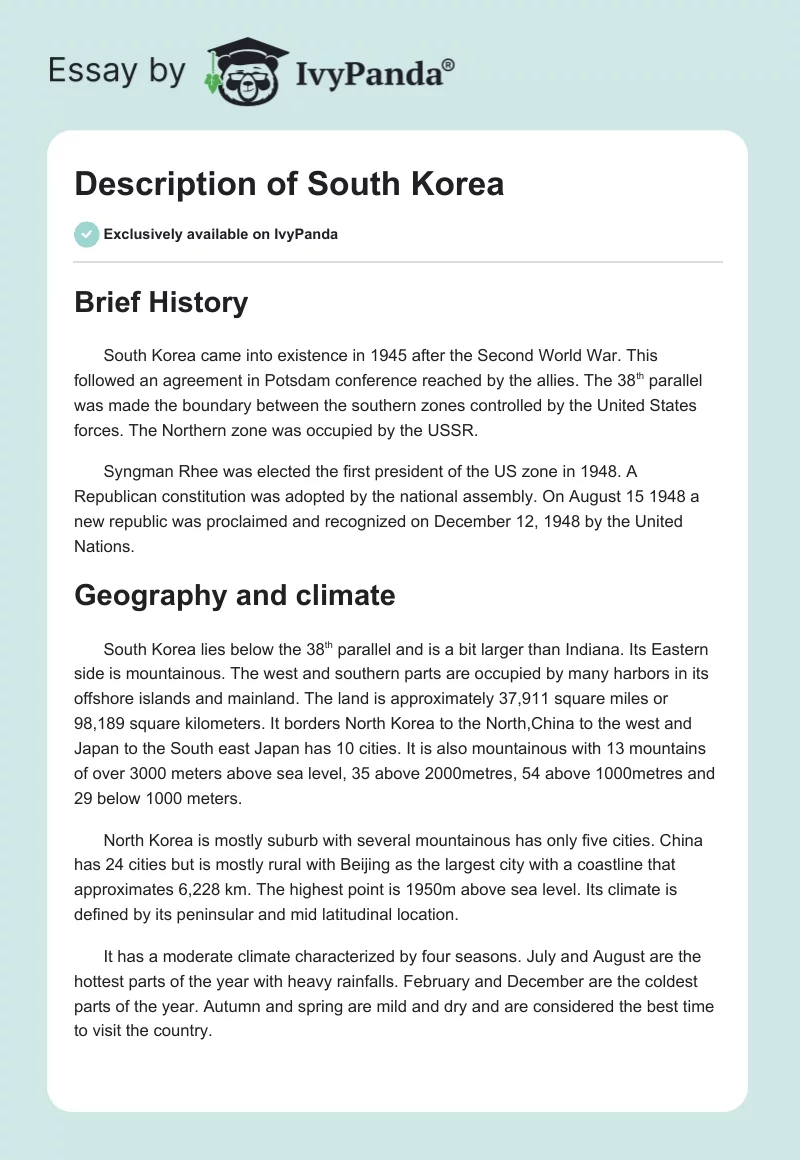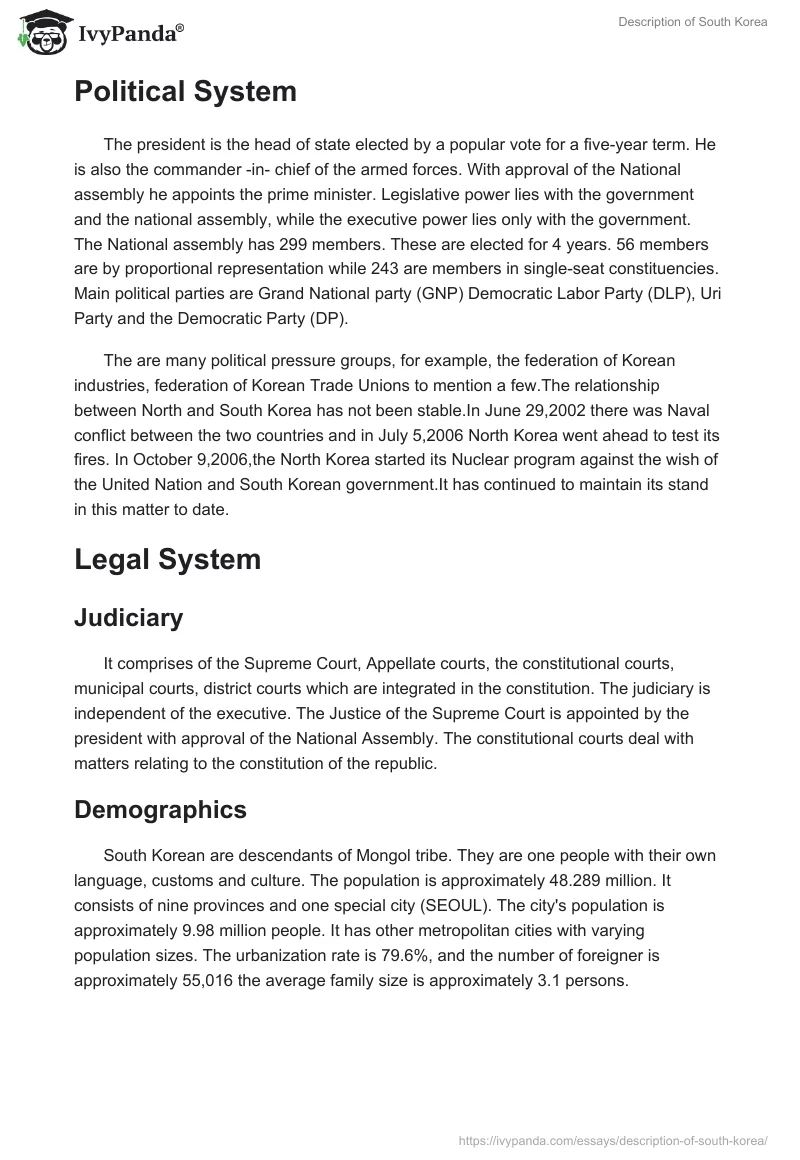Brief History
South Korea came into existence in 1945 after the Second World War. This followed an agreement in Potsdam conference reached by the allies. The 38th parallel was made the boundary between the southern zones controlled by the United States forces. The Northern zone was occupied by the USSR.
Syngman Rhee was elected the first president of the US zone in 1948. A Republican constitution was adopted by the national assembly. On August 15 1948 a new republic was proclaimed and recognized on December 12, 1948 by the United Nations.
Geography and climate
South Korea lies below the 38th parallel and is a bit larger than Indiana. Its Eastern side is mountainous. The west and southern parts are occupied by many harbors in its offshore islands and mainland. The land is approximately 37,911 square miles or 98,189 square kilometers. It borders North Korea to the North,China to the west and Japan to the South east Japan has 10 cities. It is also mountainous with 13 mountains of over 3000 meters above sea level, 35 above 2000metres, 54 above 1000metres and 29 below 1000 meters.
North Korea is mostly suburb with several mountainous has only five cities. China has 24 cities but is mostly rural with Beijing as the largest city with a coastline that approximates 6,228 km. The highest point is 1950m above sea level. Its climate is defined by its peninsular and mid latitudinal location.
It has a moderate climate characterized by four seasons. July and August are the hottest parts of the year with heavy rainfalls. February and December are the coldest parts of the year. Autumn and spring are mild and dry and are considered the best time to visit the country.
Political System
The president is the head of state elected by a popular vote for a five-year term. He is also the commander -in- chief of the armed forces. With approval of the National assembly he appoints the prime minister. Legislative power lies with the government and the national assembly, while the executive power lies only with the government. The National assembly has 299 members. These are elected for 4 years. 56 members are by proportional representation while 243 are members in single-seat constituencies. Main political parties are Grand National party (GNP) Democratic Labor Party (DLP), Uri Party and the Democratic Party (DP).
The are many political pressure groups, for example, the federation of Korean industries, federation of Korean Trade Unions to mention a few.The relationship between North and South Korea has not been stable.In June 29,2002 there was Naval conflict between the two countries and in July 5,2006 North Korea went ahead to test its fires. In October 9,2006,the North Korea started its Nuclear program against the wish of the United Nation and South Korean government.It has continued to maintain its stand in this matter to date.
Legal System
Judiciary
It comprises of the Supreme Court, Appellate courts, the constitutional courts, municipal courts, district courts which are integrated in the constitution. The judiciary is independent of the executive. The Justice of the Supreme Court is appointed by the president with approval of the National Assembly. The constitutional courts deal with matters relating to the constitution of the republic.
Demographics
South Korean are descendants of Mongol tribe. They are one people with their own language, customs and culture. The population is approximately 48.289 million. It consists of nine provinces and one special city (SEOUL). The city’s population is approximately 9.98 million people. It has other metropolitan cities with varying population sizes. The urbanization rate is 79.6%, and the number of foreigner is approximately 55,016 the average family size is approximately 3.1 persons.
Languages
Korean is the official language of the people. The other language is English which is widely taught in schools.
Social/Ethic groups
The South Korean ethnicity is homogenous except for the foreigners, for example, the Chinese who are about 20,000 in number out of the 55,016 foreigners in South Korea.
Religion
Different religions exist in the country. Christians make 47%, Confucianists make 3%, Buddhist make 47% and others make 1%.
Education System
The country has 98% literacy rate. The system comprises of the primary education, Secondary education, and the higher University education.
Primary Education
Students from the ages of (6-12) years attend the primary education, which is grade (1-6). The curriculum consists of Mathematics, Korean, Fire arts, Music and Physical education, Natural science and moral education. No leaving certificate is awarded for completion of primary education.
Secondary education
This is also called the middle school. It is attended by students of (12-15) years. This is for grades (7-9). The curriculum consists of, Korean, Mathematics and English. The diploma certificate is awarded for completion of middle level stage. The vocational high school is also attended by those aged 16 to 18 years and the curriculum consists of agricultural, commercial, fishery marine, home economics and technical subjects.
Higher Education
The university education offers bachelors degrees, masters degrees and the PhD. Non- university education comprises of health education, early childhood education, Engineering arts and Textiles. A certificate of completion is awarded. Primary school teachers are trained for four years in colleges and awarded a bachelors degree to teach in primary schools. Secondary school teachers are also trained for four years and bachelors degrees awarded to the graduates in the faculties of the universities.
Cultural Organizations
The culture is distinguished by different colors and lines. People use popular ballads or lyrics to vent their sadness. They also have folk songs that characterize different occasions. Traditional sports like boxing, taekwondo and others are popular. Tourists are mostly attracted by the rich Korean culture.
Living Conditions
People live in semi-furnished apartments with shared beds, fridges, T.V, VCR appliances. Living standards depends on ones salary.The bigger the salary the comfortable the life and vice versa. In spite of this, living is cheap in South Korea for example, night outs are cheap, food and other basic needs are also cheap.
Food
Different types of food are prepared for different seasons and occasions. Ttok Kuk (rice cake soup) is prepared during the New Year. Ogok-bap (five grain-rice e.g. red beans, millet, black beans and Indian millet) is prepared during the day of the first full moon. Chunchi-guk (fish soup) is eaten during (Tano) or when heat of summer begins.
Housing
There are rental apartments, serviced residential houses, weekly mansions, flats, homes and real estates in South Korea.
Clothing
Korean traditional dress is called hanbok it has simple lines and no pockets. Women wear a wrap skirt and bolere-like jacket; Men wear roomy pants and short jackets.
Recreation
Different sports are used for recreation, for example, the folk dances, kite flying, bull fighting and Korean wrestling.Various stadia are built for recreation, for example, Seoul Olympic stadium (1988)
Health Care
Various health care remedies exist, for example ,cold and allergy remedies, ear care emergency, contraception, eye care, OTC obesity, to mention a few. Health care facilities are widespread all over the country.
Infrastructure
The main infrastructure in South Korea are Railways (3,125km), waterways (1,609km) ,Ports and harbors, Airports (102) and highways (86,990 km ) The paved highways are 64,808km, unpaved 22,182km.
Transportation
This is mainly carried out using vehicles, trains, ship and aeroplanes. This is made possible through its networked infrastructure.
Telecommunications
Communication is carried out through telephones with 24 million lines in use. It is also done using Internet service providers (ISP) with 25.6 million users. Radio and television broadcasting stations are also used.
Trade Restrictions
There are import restrictions, prohibitive tariffs, import taxes, non- transparent and restrictive regulations and standards which increase the cost of trading in South Korea.
Government Treaties
Several treaties have been made by the government of South Korea. First is the agreement (treaty) between South Korea and Japan concerning fisheries? Second the treaty between republic of South Korea and Japan on legal status, and how South Koreans should be treated in Japan. Third is the treaty on settlement of disputes on property and economic co-operation between the two countries.
Business customs and practices
Prior appointment is required a few weeks in advance before any business is done in South Korea. The best time to arrange for business meetings is between 2 pm and 4 pm and 10 am 12 pm. Proposals, marketing materials, company brochures should be written in two languages that is English and Korean and must be submitted beforehand.Agriculture is the traditional work of the Koreans with a maximum of 5 to 6 working hours per day. North Korea ,China,Japan and the United States are the largest trading partners.
country exports (billions) imports(billion)
United states $10708 $ 16234
China $18458 $12348
Japan $20466 $31556
Currency
The official currency is won. The popularly used is the 100 won. It is pegged at 2.16 won per US dollar the rate is determined by forces of supply and demand.
Exchange restrictions
Liberalization of foreign exchange market (1992) to bring in more foreign currencies and prevent the flight of resources from the country, monitoring and Tax regulations to allow more foreign currency inflow.
Payment
Accepted method of payment is through postal order (giro note).
Banks
Several banks operate in the country, for example, World Bank. Korea exchange bank, Koo kmin bank, Korea international merchant bank, Kwangju bank, shinhan bank and Pusan bank.
Cash transfers
Cash can be transferred using credit or debit cards.Receiver of the cash gets a visa R prepaid card via FedEx and can withdraw from any visa ATM. The sender uses a bank account or a Visa master card
Payment restrictions
The limited deferred payment methods (60-90) day is restricted to a commodity with tariffs of 10% or less. Other goods require a license from foreign exchange bank for them to be paid through the differed payments methods.
Trade and industry organizations embassies/ consulates
Embassies/ Consulates in South Korea
Seoul is home to various countries embassies. There are 15 embassies so far with more diplomatic relations being made to increase relations with other countries. The country has also its embassies spread all over the world.
Chamber of commerce and industry
There are several chambers of commerce in the country. The American chamber of commerce was founded to enhance trade between South Korea and US. Korea chamber of commerce and industry was to provide improvement and development in Koreans commerce.
Korean- German chamber of commerce and industry is an agent between Korea and German firms.
US Beef Council
On 7th September, South Korea resumed importation of US boneless beef. This was only to be done if the cattle were less than 30 months in age. $814 million worth of beef were exported in 2003.
References
Yugui, G. (2005), Asia’s Educational Edge, Current achievements in Japan and South Korea, MD: Lexington Books.
Culture in South Korea. Web.
Food in South Korea. Web.
Betsy O,Lets eat Korean Food.
Life in South Korea. Web.
Korean culture. Web.
Different types of food in South korea. Web.


